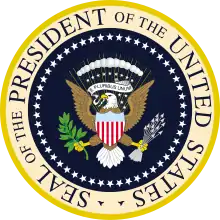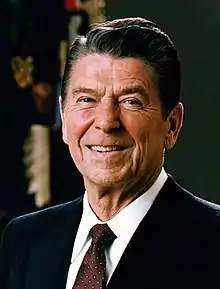Presidential transition of Ronald Reagan
The presidential transition of Ronald Reagan began when Ronald Reagan won the United States 1980 United States presidential election, becoming the President-elect, and ended when Reagan was inaugurated at noon EST on January 20, 1981.
| Formation | November 4, 1980 |
|---|---|
| Dissolved | January 20, 1981 |
| Type | Quasi-governmental–private |
| Purpose | Presidential transition |
| Headquarters | 1726 M Street, Washington, D.C.[1] |
| Leader | Edwin Meese |
| ||
|---|---|---|
Transitions
Planned transitions
|
||
| ||
|---|---|---|
|
Governor of California
40th President of the United States
Policies
Appointments
First term
Second term
Presidential campaigns Post-presidency
Legacy
|
||
Pre-election developments
Plans for a potential presidential transition by Reagan began before the Republican National Convention.[2]
By September of 1980, Reagan associates have formed a Presidential Transition Trust to collect contributions to finance a transition effort that would search for candidates to fill key positions in a Reagan administration.[3] Lawyers of the Federal Election Commission, in September, drafted an advisory opinion that stated that, so long as the transition trust was "completely separate" from Reagan's campaign committee and funds raised by the trust did not go towards assisting in Reagan's election, such an trust would be allowed to operate outside of campaign finance laws that limited individual contributions to $1,000 (and Political Action Committee contributions to $5,0000).[3][4] The trust opted to voluntarily limit contributions to a maximum of $5,000 per individual.[3]
Official transition
Reagan's transition was headed by Edwin Meese.[2][5] The role of the administration of outgoing president Jimmy Carter in the transition was overseen by his White House Chief of Staff Jack Watson, who had overseen Carter's own transition four years prior.[1][5] In contrast to Watson's approach during Carter's own transition, James kept a generally low public profile during Reagan's transition.[2]
William Timmons oversaw the Reagan transition team's assessment of existing programs and policies.[6] Verne Orr was in charge of administrative and budgetary matters.[4] Another key member of the transition was William French Smith.[7] A number of key staffers of the transition, had previously worked on the presidential transition of Richard Nixon. One was Pendleton James, a personnel recruiter in the Reagan transition, who had previously been the manager of Nixon's transition.[2] Other alumni of the Nixon transition working on Reagan's transition included Reagan transition's policy chiefs Martin Anderson and Richard Allen.[2]
Reagan's transition was particularly large.[1] The transition involved more than 1,000 people, including both volunteers and paid staff.[4][2][8] The transition involved a hundred individual transition teams for federal agencies, which, for organizational purposes, were divided into five clusters. The five clusters were economic affairs, national security, human services, resources and development, and legal-administrative.[1]
The transition team worked in close partnership with conservative think tanks like the American Enterprise Institute, Heritage Foundation, and Hoover Institution.[2] Among the plans given to them by such organizations was the Heritage Foundation's Mandate for Leadership, a 1,000-page plan for restructuring the executive branch.[2] The Heriage Foundation also ran a job bank providing the transition team with lists of personnel aligned with conservative ideology, and also ran a number of orientation sessions for top appointees of the incoming administration.[2]
The transition was headquartered in Washington, D.C.[9] In the early weeks of the transition, Reagan remained on the West Coast, meeting with a "kitchen cabinet" of advisors.[1] However, within weeks of his election, Reagan moved into a row house in Washington, D.C., which would serve temporary quarters for him until he was sworn-in as president.[10]
On November 20, President Carter hosted President-elect Reagan at the White House.[11]
Reagan began announcing key appointments to his administration two week after his election victory.[12] By the seventh week of the transition, most appointements had been announced.[7] He had finished announcing key appointees by the tenth week of his transition.[12]
Reagan had originally favored choosing Meese for his White House Chief of Staff, but some of his advisors convinced him to instead pick James Baker.[2]
The first Cabinet nominees Reagan designated were largely uncontroversial, and even received praise from both the business community and the moderate wing of the Republican Party.[6] However, several later choices he named, such as Alexander Haig for Secretary of State and James G. Watt for Secretary of the Interior, promised to be controversial.[6]
The transition saw Mark Anderson and David Stockman, Reagan's choice for Director of the Office of Management and Budget, shape the incoming administration's economic policy agenda.[2]
Reagan pledged not to speak publicly on policy matters until his inauguration. However, many of his advisers spoke publicly about issues, often creating problems where the transition's press secretary James Brady would have to disavow their statements.[6] There were unofficial statements and news leaks made by members of Reagan's administration that attracted criticism from the Carter administration's State Department.[6]
While many aspects of the transition period operated smoothly, there were hiccups.[6] There was controversy surrounding involvement of Jackie Presser in the transition.[6] The Carter administration alleged that some staffers of the transition had possible conflicts of interest.[6] There was also public speculation over the degree to which Reagan was involved in his own transition.[6] Many scholars have, retrospectively, considered the Reagan transition as to have been a successfully managed presidential transition.[2]
Finances
As per legislation passed in 1976, the federal government gave $3 million to fund the transition, with $2 million going to the president-elect and $1 million going to the outgoing president.[13][14] The outgoing administration of Jimmy Carter spent $861,526 of the $1 million it was allotted by the federal government, with the team of the outgoing president utilizing $672,659 and the team of the outgoing vice president, Walter Mondale, utilizing $188,867.[14] The Reagan team spend $1.75 of the federal money granted to it.[14] Of this amount, $63,378 went to Vice President-elect George H. W. Bush for personal compensation and benefits.[14]
The Government Accountability Office would find that, in their use of government funds, the Reagan transition team did not always follow correct procedures. For instance, they gave salary to employees of federal agencies who had been assigned to the transition effort on a non-reimbursable basis.[14]
The Reagan transition team also raised private contributions to further fund the transition, soliciting contributions through the private corporation Presidential Transition Foundation, Inc.[14] They raised approximately $1.25 million.[14] The foundation would later deny requests by the Government Accountability Office to audit these funds.[14] Neither the funding sources nor the expenditures made with these funds have ever been disclosed to the public.[14]
Congressional testimony would later reveal that some of the Reagan transition spending had gone to hotel bills, payments to Nancy Reagan's decorator, tuxedo rental, parties, and parking tickets.[15]
Reagan's transition was, ultimately, more expensive than any previous transition.[16]
Iran hostage crisis
During the transition, the Carter administration continued work on resolving the Iran hostage crisis. Negotiations were completed with the signing of the Algiers Accords on January 19, 1981, and the hostages were released on January 20, 1981, minutes after Reagan completed his 20‑minute inaugural address after being sworn-in.[17][18]
External links
References
- Pfiffner, James P. (1983). "The Carter-Reagan Transition: Hitting the Ground Running". Presidential Studies Quarterly. pp. 623–645. Retrieved 4 February 2021.
- Skinner, Richard (5 October 2016). "Jimmy Carter changed presidential transitions forever". Vox. Retrieved 4 February 2021.
- Epstein, Aaron (11 Sep 1980). "Reagan aides plan for transition". Newspapers.com. Detroit Free Press. Retrieved 4 February 2021.
- Rosenbaum, David E. (9 Dec 1980). "Reagan Transition Costs Will Exceed $2 Million". Newspapers.com. The Times Argus. Times News Service. Retrieved 4 February 2021.
- Hanchette, John (12 Nov 1980). "Presidential transition: It doesn't always happen smoothly". Newspapers.com. The Ithaca Journal. Gannett News Service. Retrieved 4 February 2021.
- Wehr, Elizabeth (4 Jan 1981). "U.S. presidential transition results continue to vary". Newspapers.com. Asbury Park Press. Congressional Quarterly. Retrieved 4 February 2021.
- Hess, Stephen (1 March 2001). "First Impressions: A Look Back at Five Presidential Transitions". Brookings. Retrieved 4 February 2021.
- Gellman, Barton; Balz, Dan (29 October 1992). "CLINTON TRANSITION TEAM READY TO HIT THE GROUND RUNNING". Washington Post. Retrieved 5 February 2021.
- Cromley, Allan (8 Jan 1981). "Shelby May Get White House Job". Newspapers.com. The Daily Oklahoman. Retrieved 4 February 2021.
- "The transition of the U.S. presidency from Jimmy Carter to Ronald Reagan | CBC Archives". CBC. 19 November 2020. Retrieved 4 February 2021.
- "Photos: Presidents in Post-Election Transition". WSJ. Retrieved 6 February 2021.
- Schrader, Esther; Shogren, Elizabeth (14 Dec 2000). "Bush team must scurry to name top appointees". Newspapers.com. South Florida Sun Sentinel. Los Angeles Times.
- "JUST ASK Where does the money come from to pay Bill Clinton's transition team expenses?". Newspapers.com. Democrat and Chronicle. 13 Nov 1992. Retrieved 2 February 2021.
- Smith, Stephanie (11 February 2008). "CRS Report for Congress Presidential Transitions" (PDF). Congressional Research Service. Retrieved 29 January 2021.
- McClendon, Sarah (24 Apr 1988). "Planning Presidential Transition". Newspapers.com. The Tyler Courier-Times. Retrieved 5 February 2021.
- "Private parties, public presidency". Newspapers.com. The News. 12 Jun 1981. Retrieved 4 February 2021.
- Weisman, Steven R. (January 21, 1981). "Reagan Takes Oath as 40th President; Promises an 'Era of National Renewal'—Minutes Later, 52 U.S. Hostages in Iran Fly to Freedom After 444-Day Ordeal". The New York Times. p. A1. ISSN 0362-4331. Archived from the original on August 29, 2019. Retrieved August 25, 2020.
- "Iranian Hostages Released – 1981 Year in Review – Audio". UPI.com. Retrieved May 5, 2016.
| Preceded by Jimmy Carter |
Presidential transition 1980-1981 |
Succeeded by George H. W. Bush |

